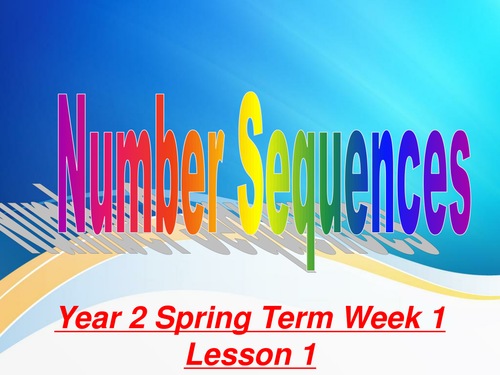













Three complete PowerPoint lessons about number sequences. The lessons start with a fun mental warm up, followed by a whole class learning period, and finishes with a set of differentiated learning challenges.
Spring Term
Lesson 1: Week 1
Title Number Sequences
Learning Objective: count on and back in steps of 10
describe and continue a sequence
make up a number pattern.
Mental Warm Up: Today you are going to complete a mapping diagram with a ‘+10’ rule.
Main Lesson Idea: Today we are going to be looking at sequences of numbers that have been made by counting on or back in steps of 10 or 1.
Educational Challenges Use cubes or beads in two colours to make a number sequence. Use the ‘+10’ or ‘–10’ rule.
Make a pattern using cubes or beads in two colours. Use the ‘+10’ or ‘–10’ rule.
Think of a way to show a sequence that has got hundreds in it.
Lesson 2: Week 1
Title Counting and Properties of Numbers
Learning Objective: count on and back in steps
describe a number pattern
continue a number pattern
make predictions.
Mental Warm Up: Start from the start number. Count back in steps of ten when I clap my hands.
Main Lesson Idea: Today we are going to count on in steps of different sizes using some grids.
Educational Challenges Shade the first number on a 4 x 4 grid and count on in fours. Do the same for a 5 x 5 grid and a 6 x 6 grid. Does the pattern look the same?
Count on in steps of 4 on different-sized grids. Explain the pattern.
Count on in steps of 4 on different-sized grids. Predict the pattern.
Lesson 3: Week 1
Title Number Sequences
Learning Objective: count on or back in steps
describe number patterns
continue number patterns
make predictions.
Mental Warm Up: Sit in a circle. Collect a card between 0 and 30. Stand up if you have number cards 1, 4, 7 and 10. What is the next number? Stand up if you have the number.
Main Lesson Idea: Today we are going to look at some number patterns and work out the rule.
Educational Challenges Work out the rule for shaded grid patterns. Write the number sequences.
Work out the rule for shaded grid patterns. Write the number sequences.
Work out the rule for shaded grid patterns. Make up a pattern for a friend using a two-step rule.
Spring Term
Lesson 1: Week 1
Title Number Sequences
Learning Objective: count on and back in steps of 10
describe and continue a sequence
make up a number pattern.
Mental Warm Up: Today you are going to complete a mapping diagram with a ‘+10’ rule.
Main Lesson Idea: Today we are going to be looking at sequences of numbers that have been made by counting on or back in steps of 10 or 1.
Educational Challenges Use cubes or beads in two colours to make a number sequence. Use the ‘+10’ or ‘–10’ rule.
Make a pattern using cubes or beads in two colours. Use the ‘+10’ or ‘–10’ rule.
Think of a way to show a sequence that has got hundreds in it.
Lesson 2: Week 1
Title Counting and Properties of Numbers
Learning Objective: count on and back in steps
describe a number pattern
continue a number pattern
make predictions.
Mental Warm Up: Start from the start number. Count back in steps of ten when I clap my hands.
Main Lesson Idea: Today we are going to count on in steps of different sizes using some grids.
Educational Challenges Shade the first number on a 4 x 4 grid and count on in fours. Do the same for a 5 x 5 grid and a 6 x 6 grid. Does the pattern look the same?
Count on in steps of 4 on different-sized grids. Explain the pattern.
Count on in steps of 4 on different-sized grids. Predict the pattern.
Lesson 3: Week 1
Title Number Sequences
Learning Objective: count on or back in steps
describe number patterns
continue number patterns
make predictions.
Mental Warm Up: Sit in a circle. Collect a card between 0 and 30. Stand up if you have number cards 1, 4, 7 and 10. What is the next number? Stand up if you have the number.
Main Lesson Idea: Today we are going to look at some number patterns and work out the rule.
Educational Challenges Work out the rule for shaded grid patterns. Write the number sequences.
Work out the rule for shaded grid patterns. Write the number sequences.
Work out the rule for shaded grid patterns. Make up a pattern for a friend using a two-step rule.
Get this resource as part of a bundle and save up to 32%
A bundle is a package of resources grouped together to teach a particular topic, or a series of lessons, in one place.
Something went wrong, please try again later.
This resource hasn't been reviewed yet
To ensure quality for our reviews, only customers who have purchased this resource can review it
Report this resourceto let us know if it violates our terms and conditions.
Our customer service team will review your report and will be in touch.
£5.00